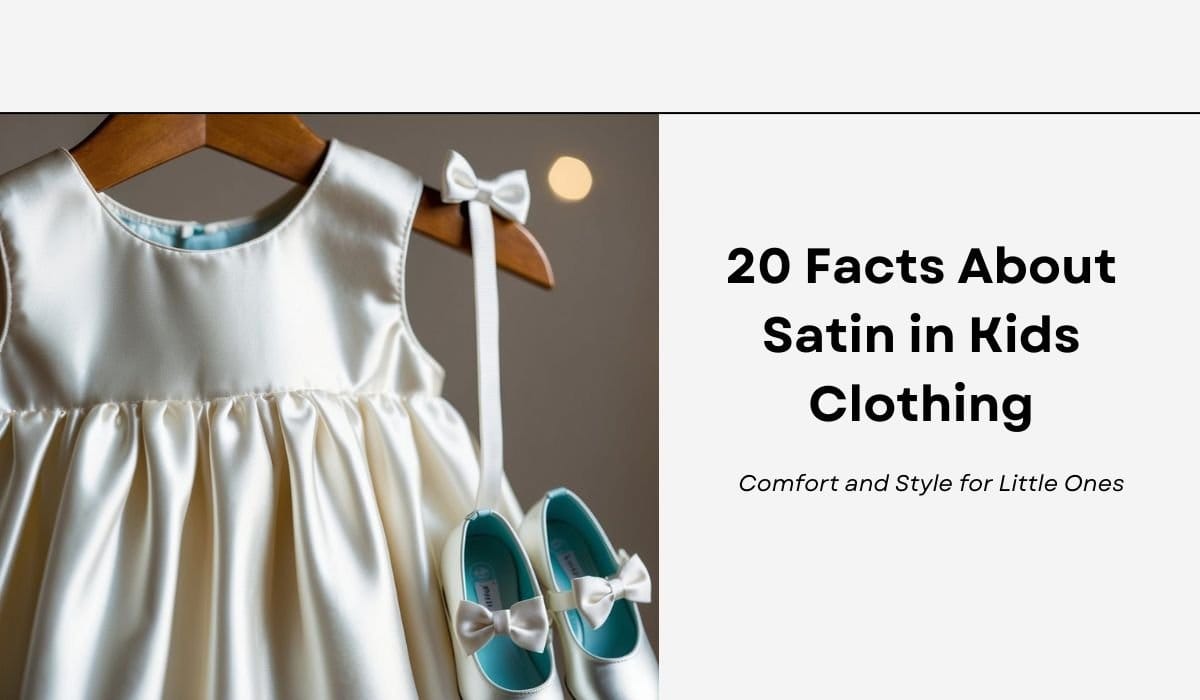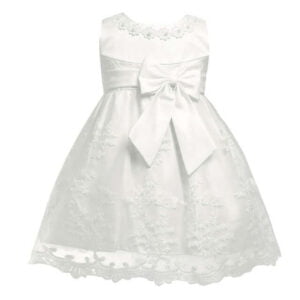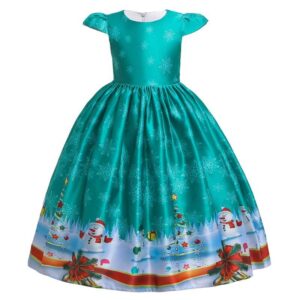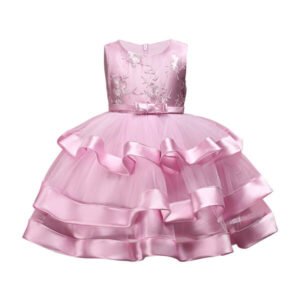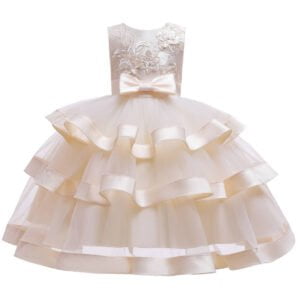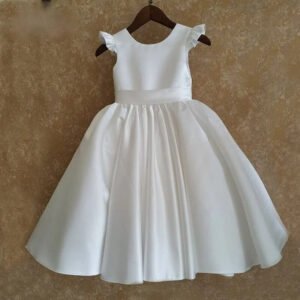A Parent’s Guide to Understanding Why Satin Is Becoming a Popular Choice in Children’s Fashion
Satin fabric has long been associated with luxury and elegance in clothing. When it comes to kids’ clothing, satin adds a touch of sophistication for special occasions. Satin fabric can be a great choice for children’s garments, especially for dressy outfits like party dresses or fancy skirts.
The smooth, glossy surface of satin creates a eye-catching look that stands out. Satin is known for its flowing drape, which can create beautiful movement in children’s clothing. This fabric can make even simple designs appear more refined and special.
While satin offers many benefits for kids’ clothing, it does require some special care. Parents should be aware of proper washing and ironing techniques to keep satin garments looking their best. With the right care, satin clothing can be a lasting addition to a child’s wardrobe for those important events.
On This Page
Key Takeaways
- Satin adds elegance to children’s special occasion clothing
- The fabric’s smooth surface and flowing drape create a refined look
- Proper care is essential to maintain satin’s appearance in kids’ garments
The History of Satin
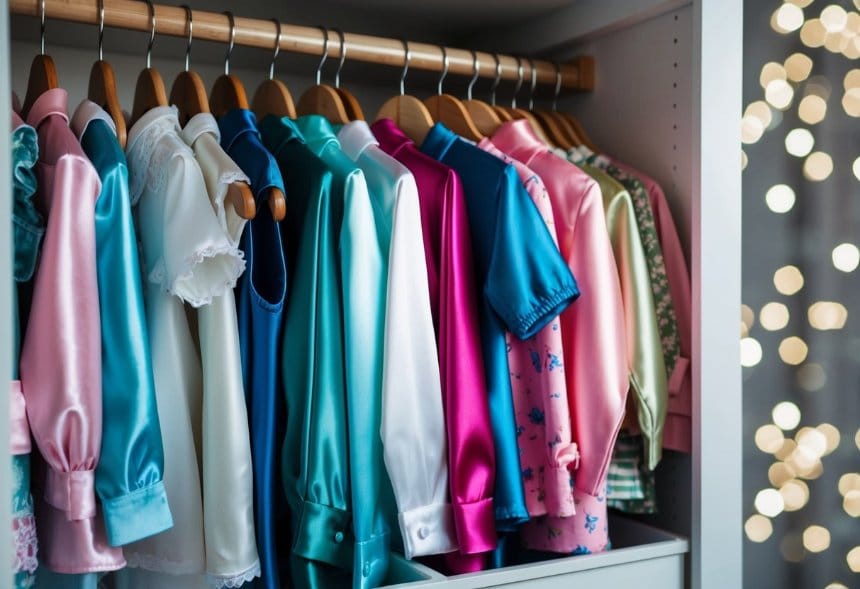
Satin has a rich history spanning centuries. Its journey from ancient times to modern fashion is filled with royal connections and industrial developments.
Ancient Beginnings and Royal Associations
Satin’s story begins in ancient China. Silk weavers created this luxurious fabric between 960 and 1127 AD. The smooth, glossy cloth quickly caught the eye of royalty.
Kings and queens across Europe prized satin for its elegance. They used it for grand robes and fancy furnishings.
In the Middle Ages, satin became a symbol of wealth and power. Only the rich could afford its high cost.
Satin in the Fashion Industry Through the Ages
By the 1800s, satin had become a favourite in the fashion world. Queen Victoria helped make it popular by wearing satin gowns.
Designers loved satin’s shine and flow. They used it for:
- Evening dresses
- Wedding gowns
- Fancy shoes
As production methods improved, satin became more affordable. This allowed more people to enjoy its beauty.
Satin During World War II
World War II changed satin’s role. Factories switched to making parachutes and military uniforms.
After the war, satin bounced back in fashion. It appeared in:
- Glamorous Hollywood costumes
- Stylish everyday clothing
Satin’s ability to adapt helped it stay popular. Today, it remains a key fabric in fashion and home decor.
The Science and Manufacture of Satin
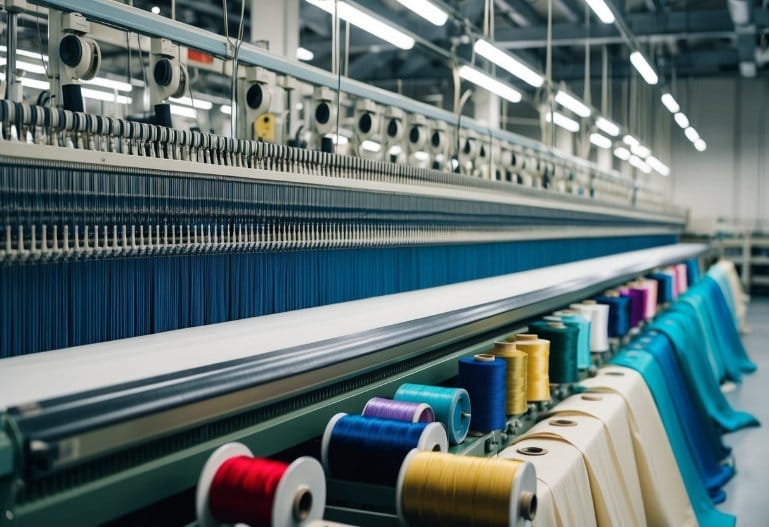
Satin’s unique properties come from its weave structure and materials. This smooth fabric relies on specific techniques and fibres to achieve its signature lustre and feel.
Understanding Satin Weave Techniques
Satin weave creates a glossy surface by floating long warp yarns over weft yarns. This technique leaves more thread visible on the fabric’s face. Weavers use different ratios, like 4/1 or 8/3, to vary the satin’s appearance.
The back of satin looks duller due to the shorter floats. This asymmetry gives satin its distinct look and feel.
Modern looms can produce satin quickly. But some high-end satin is still made on traditional shuttle looms for better quality control.
Satin vs Sateen
Satin and sateen use similar weaves but differ in yarn placement. Satin has long floats on the face, while sateen has them on the back.
Sateen is often made from cotton, giving it a softer feel. It’s less shiny than satin but more durable for everyday use.
Both fabrics share a smooth surface, but satin tends to be more lustrous. Sateen is typically cheaper and easier to care for.
Materials Used in Satin Production
Silk was the original fibre for satin, prized for its natural sheen. Today, manufacturers use various materials to create satin:
- Silk: Luxurious and lightweight
- Polyester: Affordable and durable
- Rayon: Soft with a silk-like drape
- Cotton: Used mainly for sateen
Synthetic fibres like polyester can mimic silk’s properties at a lower cost. This has made satin more accessible for children’s clothing.
Blends of natural and synthetic fibres are common. They combine the best qualities of each material for improved performance and feel.
Characteristics and Benefits of Satin in Kids Clothing
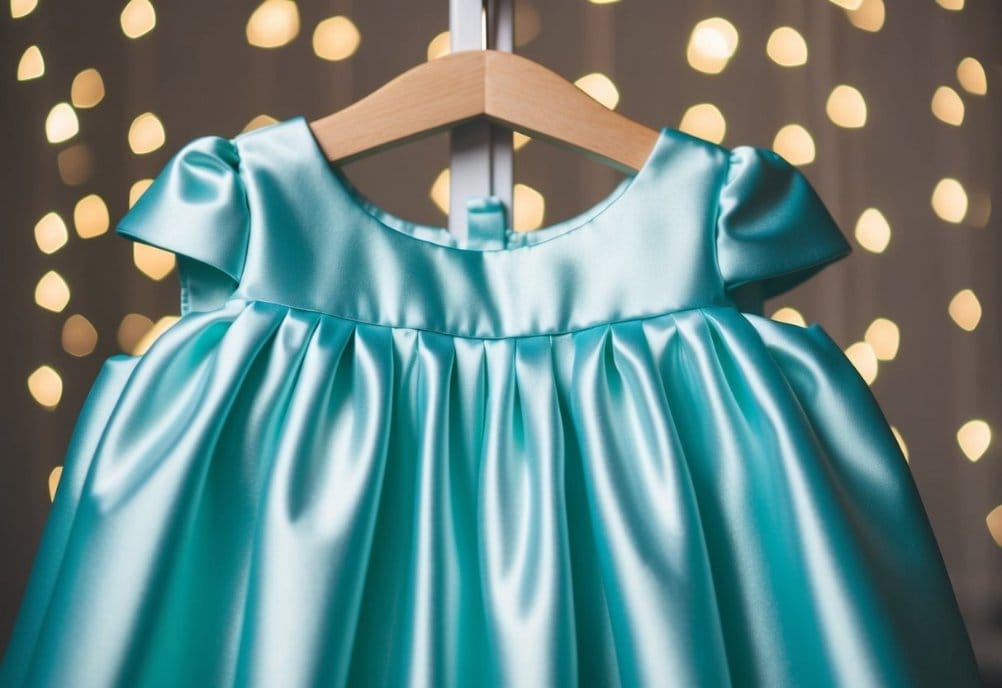
Satin offers unique qualities that make it an excellent choice for children’s clothing. Its smooth texture and versatile properties provide both comfort and style for young wearers.
The Comfort and Durability of Satin
Satin fabric is known for its softness against the skin, making it comfortable for children. The smooth surface reduces friction, preventing irritation and allowing kids to move freely.
Satin’s durability depends on its composition. While pure silk satin requires careful handling, synthetic satin blends can withstand regular wear and tear. These blends are often used in kids’ clothing to balance luxury with practicality.
Some satin fabrics, like Dutchess satin, have a higher thread count and weight. This makes them suitable for special occasion wear that can endure a child’s active lifestyle while maintaining its shape and appearance.
The Hypoallergenic Nature of Satin
Satin’s smooth surface makes it less likely to trap allergens, making it a good choice for children with sensitive skin or allergies. This quality helps reduce the risk of skin irritation and rashes.
Natural silk satin is particularly beneficial for its hypoallergenic properties. It’s resistant to dust mites, mould, and mildew, which can trigger allergic reactions in some children.
Satin pillowcases and bedding can also be beneficial. They can reduce friction on hair and skin, potentially minimising hair breakage and preventing skin irritation during sleep.
Aesthetic Appeal and Shine of Satin
Satin’s glossy surface adds a touch of elegance to children’s clothing. Its ability to reflect light creates a subtle shimmer, making it perfect for special occasions and formal wear.
The fabric drapes beautifully, creating flowing lines that enhance the overall look of garments. This quality is especially noticeable in dresses and skirts, giving a graceful appearance to young wearers.
Satin takes dye well, resulting in vibrant colours that maintain their intensity over time. This makes it an excellent choice for creating eye-catching designs in children’s clothing.
Popular Satin Clothing Items for Children
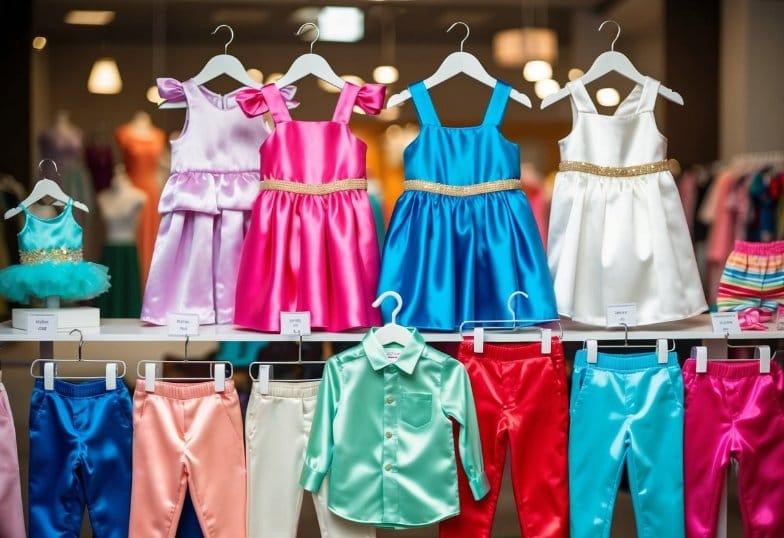
Satin adds a touch of elegance to kids’ clothing. It’s soft, shiny, and comfortable for little ones to wear. Let’s look at some common satin garments for children.
Shirts and Blouses
Satin shirts and blouses are fancy options for special events. Boys often wear satin dress shirts to formal parties or weddings. These come in white, light blue, or pastel shades. Girls’ satin blouses may have ruffles or bows for extra flair.
Some satin tops have short sleeves, while others are long-sleeved. The fabric’s smooth texture feels nice against the skin. Satin also drapes well, giving a polished look.
For everyday wear, satin-blend t-shirts offer comfort with a bit of shine. These casual tops pair well with jeans or shorts for a trendy outfit.
Skirts and Dresses
Satin dresses are popular for girls’ special occasions. They come in various styles, from simple A-line cuts to puffy princess gowns. Colours range from pastels to bold hues.
Satin skirts are versatile pieces. Girls can wear them to parties or dress them down for school. Pleated satin skirts are especially trendy. They add movement and style to any outfit.
Many satin dresses have added details like sequins or embroidery. This makes them even fancier for events like birthdays or holidays.
Recommended products
Baby girl satin dress – Ivory
Price range: £22.99 through £23.99Girl long satin Christmas dress
£24.99Girl satin and tulle party dress – Pink
£24.99Girl satin tulle occasion dress – Champagne
£24.99Girls white satin dress
£79.99
Shorts and Activewear
Satin shorts are common in children’s sportswear. They’re light, breathable, and allow for easy movement. Many football and basketball kits use satin-like fabrics.
Athletic shorts often have an elastic waistband for comfort. They may also have side pockets for storing small items. Satin shorts come in bright team colours or neutral shades.
Some casual shorts for everyday wear also use satin. These might have a softer, more relaxed fit than sports shorts. Satin-blend materials work well for playtime, as they’re durable and easy to clean.
Satin’s Role in Special Occasions and Formalwear
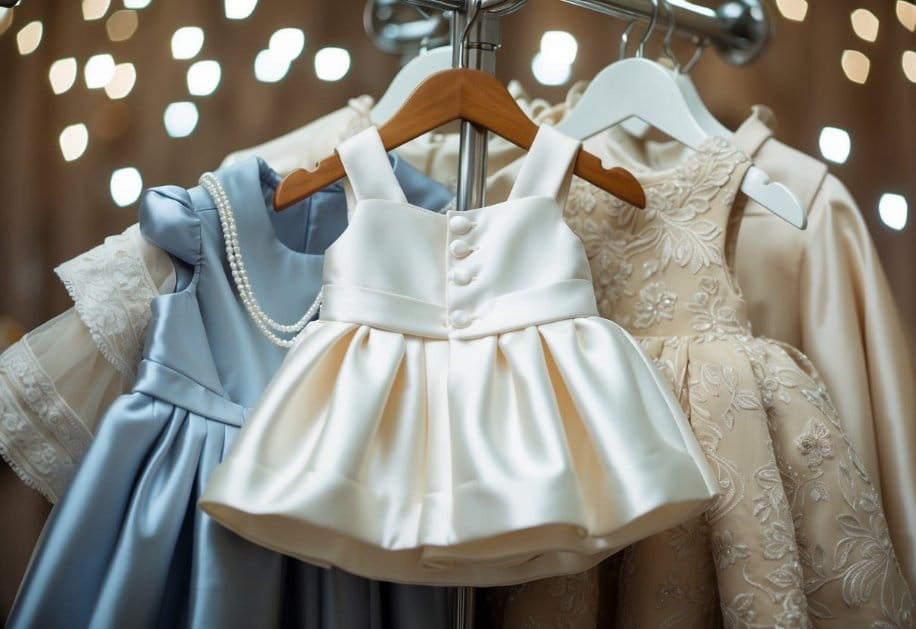
Satin fabric adds elegance and shine to many special occasion outfits. Its smooth texture and lustrous finish make it a top choice for formal events and celebrations.
Weddings and Celebrations
Satin is a popular choice for wedding dresses and bridesmaid gowns. The fabric’s glossy surface catches the light beautifully, making brides and their parties shine on the big day.
Satin is also used in other formal wear. Men’s tuxedos often feature satin lapels for a touch of luxury. The fabric’s smooth drape makes it ideal for evening gowns and cocktail dresses too.
For young attendees, satin dresses and suits can make them feel special at fancy events. The fabric’s durability means these outfits can withstand a night of dancing and celebrating.
Satin Accessories for a Polished Look
Satin isn’t just for clothes. It’s also used in many formal accessories to add a finishing touch.
Satin neckties are a classic choice for men’s formal wear. Their subtle sheen complements suits and tuxedos nicely.
For dancers, satin pointe shoes are essential. The fabric’s smooth finish allows for graceful movements on stage.
Other satin accessories include:
- Clutch bags
- Hair ribbons
- Gloves
- Bow ties
These items can elevate any outfit, adding a touch of sophistication to both adults’ and children’s formal wear.
Care Instructions for Satin Clothing
Satin garments require gentle handling to maintain their luxurious appearance. Proper cleaning, ironing, and storage techniques help preserve the fabric’s sheen and prevent damage.
Cleaning and Ironing Tips
Hand-washing or machine washing on a delicate cycle are safe methods for cleaning satin. Use cool water and a mild liquid detergent to protect the fabric. Avoid harsh chemicals that may harm the delicate fibres.
For machine washing, place satin items in a mesh bag to prevent snagging. Set the machine to a gentle cycle with cold water. Use a small amount of detergent to avoid residue buildup.
When hand-washing, submerge the garment in cool, soapy water for 30 minutes. Gently squeeze the suds through the fabric. Rinse thoroughly with cool water.
Never wring or twist satin clothing. Instead, press out excess water gently. Lay the garment flat to dry away from direct sunlight to prevent fading.
For ironing, use a low heat setting and place a clean cloth between the iron and satin. This protects the fabric’s sheen. Iron on the wrong side of the garment to avoid damaging any embroidery or beading.
Proper Storage of Satin Garments
Store satin clothing in a cool, dry place away from direct sunlight. Sunlight can fade the fabric and weaken its fibres over time.
Hang satin garments on padded hangers to prevent creases and maintain their shape. Avoid wire hangers, as they may snag or stretch the fabric.
For long-term storage, wrap satin items in acid-free tissue paper. This helps prevent yellowing and protects against dust. Place the wrapped garments in breathable cotton bags or boxes.
Keep satin away from rough fabrics like wool or linen to prevent snagging. Store beaded or embroidered satin pieces separately to avoid damage to delicate embellishments.
Consider using cedar blocks or lavender sachets in storage areas. These natural options help repel moths and keep satin garments smelling fresh.
Environmental and Ethical Considerations
Satin in children’s clothing raises some important environmental and ethical issues. The fashion industry often uses satin as a cheaper alternative to silk.
Synthetic satin made from polyester or nylon has a larger carbon footprint. Its production relies on fossil fuels and uses lots of energy. Natural satin from silk or cotton can be more eco-friendly.
Water pollution is a concern with satin production. The dyeing and finishing processes can release harmful chemicals into waterways if not managed properly.
Ethical sourcing is crucial for satin in kids’ clothing. This ensures fair labour practices and safe working conditions in factories. Some brands now use recycled materials to make satin, reducing waste.
Durability is an advantage of satin. Longer-lasting clothes mean less frequent replacement, which is better for the environment.
Clothing waste is a growing problem. About 300,000 tonnes of clothing end up in UK household bins yearly. Synthetic satin can take hundreds of years to break down in landfills.
Parents can make eco-friendly choices by:
- Buying second-hand satin items
- Choosing organic or recycled satin
- Washing satin clothes at lower temperatures
- Donating or recycling outgrown satin garments
Innovations and Trends in Satin for Kids Clothing
Satin is making a splash in children’s fashion. New styles and tech are changing how kids wear this smooth fabric.
The Influence of Celebrities and Fashion Icons
Pop stars and young actors have sparked a satin craze in kids’ wardrobes. High-fashion kids’ clothing now includes satin pieces inspired by grown-up looks.
Mini versions of red carpet gowns are popping up at kids’ events. Satin suits and blazers for boys are also gaining ground. These fancy clothes aren’t just for special days anymore.
Some brands are making satin school uniforms and gym kits. The fabric’s shine adds a posh touch to everyday wear.
Louis Vuitton has even launched a children’s line with satin items. This move brings haute couture to the playground set.
Emerging Technologies in Fabric Manufacture
New tech is making satin better for active kids. Scientists have created satin that doesn’t wrinkle as much. This means less ironing for parents.
Some companies now make satin that dries quickly. It’s great for swimwear and sporty clothes.
There’s also satin that changes colour in the sun. Kids love how their clothes look different inside and outside.
Eco-friendly satin is a big trend. It’s made from recycled plastic bottles. This helps teach kids about looking after the planet.
Smart satin is on the way too. It might have tiny sensors to check a child’s temperature or heart rate.
Frequently Asked Questions
Satin fabric offers unique qualities for children’s clothing, from its production process to care requirements. Its characteristics set it apart from other materials, making it a popular choice for certain garments.
What are the benefits of choosing satin for children’s clothing?
Satin provides a smooth and glossy surface that feels soft against a child’s skin. This makes it comfortable for special occasion wear like party dresses or formal suits.
The fabric’s sheen adds a touch of elegance to kids’ outfits, making them look polished and dressy.
How is satin fabric produced and what are its main characteristics?
Satin is created using a special weaving technique that results in a lustrous front and duller back. The fabric can be made from various fibres, including silk, polyester, or nylon.
Its main features include a smooth texture, light-reflecting properties, and a luxurious drape.
What distinguishes satin from other fabrics used in children’s apparel?
Satin stands out due to its glossy appearance and silky feel. Unlike cotton or linen, it has a more formal look that’s ideal for special events.
The fabric’s sheen catches the light, making it eye-catching and suitable for dressy children’s clothing.
Can satin fabric be suitable for children with sensitive skin?
Satin can be gentle on sensitive skin, especially when made from natural fibres like silk. Its smooth surface reduces friction against the skin.
However, some children might react to synthetic satin, so it’s best to test a small area first.
How should satin clothing be cared for to maintain its quality and appearance?
Satin requires gentle care to preserve its lustre. Hand washing or using a delicate cycle with cool water is often recommended.
Avoid harsh detergents and iron on a low setting to prevent damage to the fabric’s sheen.
What historical aspects of satin’s development are relevant to its use in kids’ clothing today?
Satin was originally woven by silk weavers in China, giving it a rich history in textile production. This heritage contributes to its continued use in formal and special occasion wear for children.
The fabric’s long-standing association with luxury and elegance makes it a popular choice for children’s party dresses and suits today.
Related Post: What You Need to Know About Satin Fabric: A Guide to Its Properties and Uses

